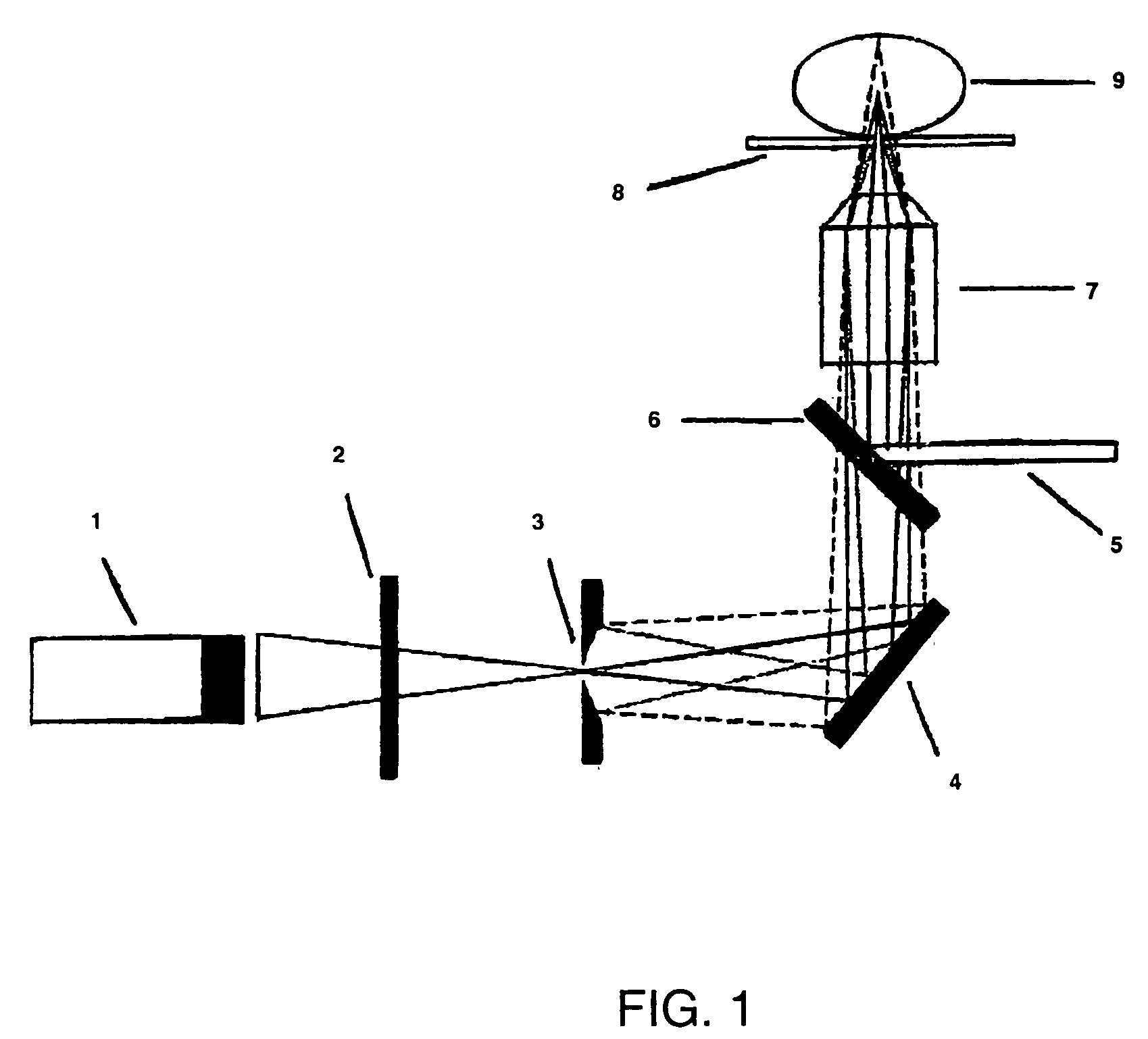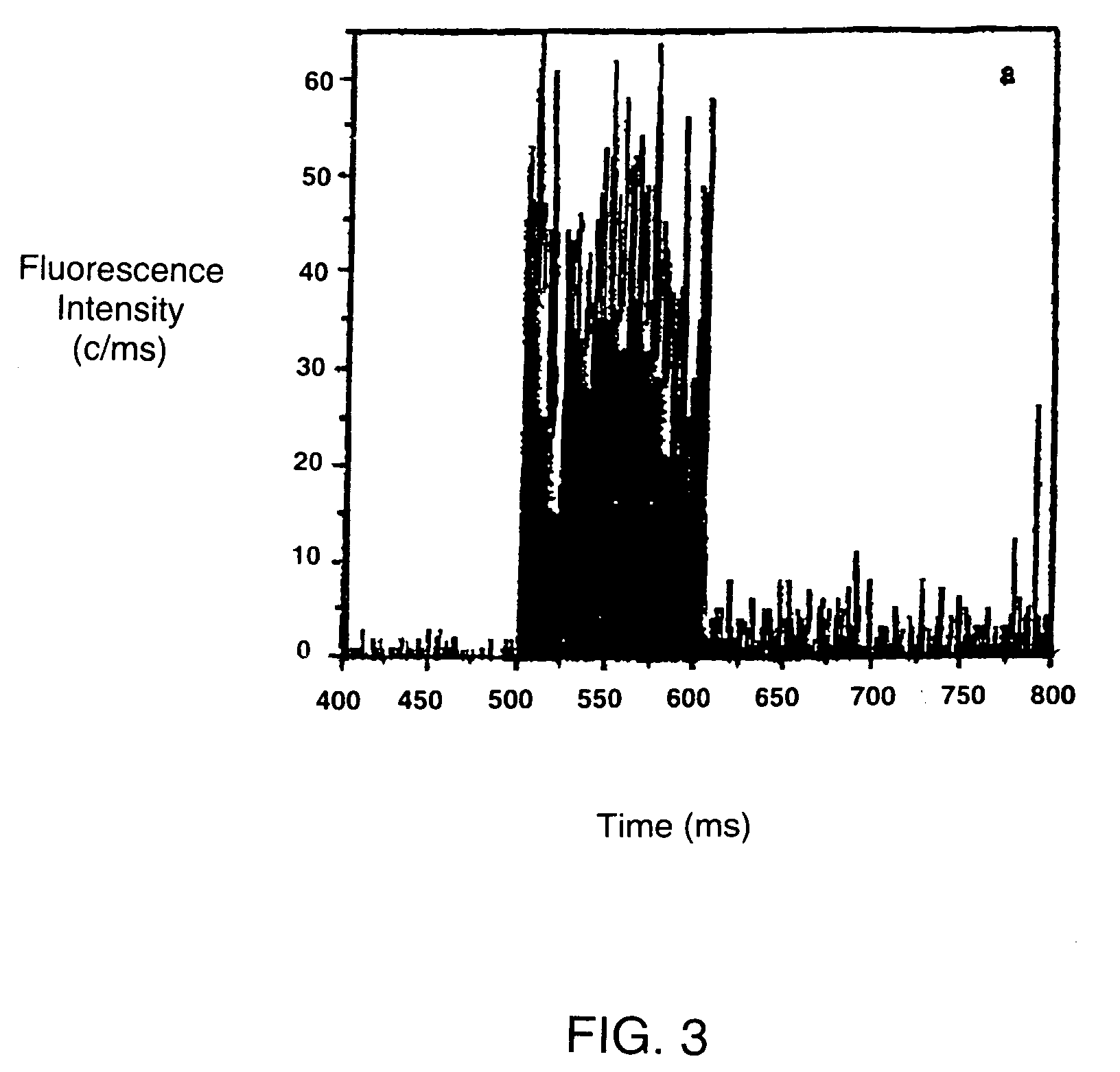Arrayed biomolecules and their use in sequencing
- Summary
- Abstract
- Description
- Claims
- Application Information
AI Technical Summary
Benefits of technology
Problems solved by technology
Method used
Image
Examples
example 1
[0090]The microscope set-up used in the following Example was based on a modified confocal fluorescence system using a photon detector as shown in FIG. 1. Briefly, a narrow, spatially filtered laser beam (CW Argon ton Laser Technology RPC50) was passed through an acousto-optic modulator (AOM) (A A Opto-Electronic) which acts as a fast optical switch. The acousto-optic modulator was switched on and, the laser beam was directed through an oil emersion objective (100×NA=1 3) of an inverted optical microscope (Nikon Diaphor 200) by a dichroic beam splitter (540DRLP02 or 505DRLP02, Omega Optics Inc). The objective focuses the light to a diffraction-limited spot on the target sample immobilised on a thin glass coverslip. Fluorescence from the sample was collected by the same objective, passed through the dichroic beam splitter and directed though a 50 μm pinhole (Newport Corp.) placed in the image plane of the microscope observation port. The pinhole rejects light emerging from the sample...
example 2
[0097]This Example illustrates the preparation of single molecule arrays by direct covalent attachment to glass followed by a demonstration of hybridisation to the array.
[0098]Covalently modified slides were prepared as follows. Spectrosil-2000 slides (TSL, UK) were rinsed in milli-Q to remove any dust and placed wet in a bottle containing near Decon-90 and left for 12 h at room temperature. The slides were rinsed with milli-Q and placed in a bottle containing a solution of 1.5% glycidoxypropyltrimethoxy-silane in milli-Q and magnetically stirred for 4 h at room temperature rinsed with milli-Q and dried under N2 to liberate an epoxide coated surface.
[0099]The DNA used was that shown in SEQ ID No. 2 (see sequence listing below), where n represents a 5-methyl cytosine (Cy5) with a TMR group coupled via a link to the n4 position.
[0100]A sample of this (5 μl, 450 pM) was applied as a solution in neat milli-Q.
[0101]The DNA reaction was left for 12 h at room temperature in a humid atmosph...
example 3
[0113]This experiment demonstrates the possibility of performing enzymatic incorporation on a single molecule array. In summary, primer DNA was attached to the surface of a solid support, and template DNA hybridised thereto. Two cycles of incorporation of fluorophore-labelled nucleotides was then completed. This was compared against a reference experiment where the immobilised DNA was pre-labelled with the same two fluorophores prior to attachment to the surface, and control experiments performed under adverse conditions for nucleotide incorporation.
[0114]The primer DNA sequence and the template DNA sequence used in this experiment are shown in SEQ ID NOS. 4 and 5, respectively.
[0115]The buffer used contained 4 mM MgCl2, 2 mM DTT, 50 mM Tris HCl (pH 7 6) 10 mM NaCl and 1 mm K2PO3 (100 μl).
[0116]Preparation of Slides.
[0117]Silica slides were treated with decon for at least 24 hours and rinsed in water and EtOH directly before use. The dried slides were placed in a 50 ml solution of 2...
PUM
 Login to View More
Login to View More Abstract
Description
Claims
Application Information
 Login to View More
Login to View More - R&D
- Intellectual Property
- Life Sciences
- Materials
- Tech Scout
- Unparalleled Data Quality
- Higher Quality Content
- 60% Fewer Hallucinations
Browse by: Latest US Patents, China's latest patents, Technical Efficacy Thesaurus, Application Domain, Technology Topic, Popular Technical Reports.
© 2025 PatSnap. All rights reserved.Legal|Privacy policy|Modern Slavery Act Transparency Statement|Sitemap|About US| Contact US: help@patsnap.com



